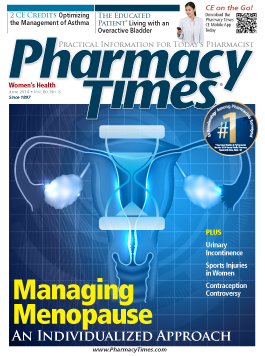Publication
Article
Pharmacy Times
Statins and OATP Interactions


In the past, this column has described drug interactions that may occur with statins.1 The majority of these interactions have been based on precipitant drugs inhibiting the metabolism (usually via CYP3A4) of the statin. Since then, new statins (pitavastatin [Livalo] and rosuvastatin [Crestor]) have been approved for use. These drugs are substrates for the organic anion transporting polypeptide (OATP). Pravastatin (Pravachol) is also a substrate for OATP; however, none of these 3 statins are substrates of CYP3A4. The other statins that are substrates of CYP3A4 or other metabolic pathways are also substrates of OATP. OATP transports the statin from the plasma into the hepatocyte. The statin can then be metabolized by hepatic enzymes or transported into the bile for elimination via the gastrointestinal tract. Interference with OATP activity results in accumulation of statin in the plasma.
Effect of Impaired OATP Activity on Statin Pharmacokinetics
Several drugs are known to inhibit OATP (eg, clarithromycin, cyclosporine, eltrombopag, erythromycin, gemfibrozil, ketoconazole, several protease inhibitors, rifampin) and have been shown to increase statin plasma concentrations.2 Because many of these drugs also affect cytochrome P450 enzymes, their total effect on a statin’s elimination is often a combination of 2 mechanisms: metabolism and hepatic uptake. For example, cyclosporine increases simvastatin’s area under the concentration-time curve (AUC) approximately 8-fold by inhibiting CYP3A4 and OATP.3 Some patients have reduced OATP function due to genetic variation in OATP activity. In these patients, simvastatin plasma concentrations are increased 3-fold.4 Gemfibrozil, whose interaction with simvastatin is primarily dependent on OATP inhibition and does not inhibit CYP3A4, produces a similar increase in simvastatin concentrations and an increased risk of myopathy.5,6 Plasma concentration of atorvastatin was 140% higher in patients with genetically reduced OATP function, while gemfibrozil increased atorvastatin concentration by 40%.7
Pravastatin, pitavastatin, and rosuvastatin are not CYP3A4 substrates. The concurrent administration of gemfibrozil results in a 1.5- to 2-fold increase in the mean AUC of these statins. This increase is due to gemfibrozil-induced OATP inhibition. The coadministration of cyclosporine with pravastatin, pitavastatin, and rosuvastatin results in AUC increases of 4- to 7-fold. It would appear that cyclosporine produces greater OATP inhibition than does gemfibrozil.
Clinical Implications of OATP Inhibitors
Gemfibrozil is the most widely studied OATP inhibitor that does not alter CYP3A4 activity. Based on the gemfibrozil-induced increase in statin plasma concentration, an increased risk of statin toxicity (muscle weakness, pain, myopathy, myositis) would be expected and has been reported. As noted above, many inhibitors of OATP also inhibit CYP3A4, thus producing a dual mechanism to raise the statin plasma concentration. The concurrent use of OATP inhibitors plus separate CYP3A4 inhibitors would produce a similar risk of elevated plasma concentrations. This dual mechanism can result in a very large increase in statin concentrations, as demonstrated by the cyclosporine—simvastatin interaction.
Inhibition of OATP may also alter the efficacy of the statin. All statins inhibit 3-hydroxy-3-methylglutaryl-coenzyme reductase found in the hepatocyte. Despite elevated plasma levels, inhibition of OATP may result in reduced hepatic statin concentration. This could diminish the lipid-lowering efficacy of the statin.
Closing Thoughts
Patients taking statins who are exposed to OATP inhibitors should be monitored for evidence of muscle toxicity and an adequate lipid-lowering response. Plasma lipid levels should be monitored to identify any reduction in therapeutic response. If possible, drugs that inhibit both CYP3A4 and OATP should be avoided in patients taking statins eliminated by both pathways (eg, simvastatin, atorvastatin).
Drs. Horn and Hansten are both professors of pharmacy at the University of Washington School of Pharmacy. For an electronic version of this article, including references, if any, visit www.hanstenandhorn.com.
References
- Horn JR, Hansten PD. Be on the alert for increasing drug interactions with statins. Pharm Times. 2006;72(6):20.
- Niemi M, Pasanen MK, Neuvonen PJ. Organic anion transporting polypeptide 1b1: a genetically polymorphic transporter of major importance for hepatic drug uptake. Pharmacol Rev. 2011;63:157-181.
- Ichimaru N, Takahara S, Kokado Y, et al. Changes in lipid metabolism and effect of simvastatin in renal transplant recipients induced by cyclosporine or tacrolimus. Atherosclerosis. 2001;158:417-423.
- Pasanen MK, Neuvonen M, Neuvonen PJ, Niemi M. SLCO1B1 polymorphism markedly affects the pharmacokinetics of simvastatin acid. Pharmacogenet Genomics. 2006;16:873-879.
- Backman JT, Kyrklund C, Kivistö KT, Wang JS, Neuvonen PJ. Plasma concentrations of active simvastatin acid are increased by gemfibrozil. Clin Pharmacol Ther. 2000;68:122-129.
- The SEARCH collaborative group. SLCO1B1 variants and statin-induced myopathy: a genome wide study. New Engl J Med.2008;359:789-799.
- Whitfield LR, Porcari AR, Alvey C, Abel R, Bullen W, Hartman D. Effect of gemfibrozil and fenofibrate on the pharmacokinetics of atorvastatin. J Clin Pharmacol. 2011;51:378-388.







